How to salt cure ham at home has been on my homesteading bucket list for a few years now. Being able to preserve food with old-fashioned techniques, like salt curing pork, is a skill I find as fascinating as I do yummy. Bring me the bacon! And ham!

When Lee from Tennessee Homestead offered to teach me and you how to salt cure a ham I got all kinds of excited. Lee, teach away!
What is Salt Curing?
Salt curing ham is an age-old tradition on our homestead. We use a dry rub cure to make the best-tasting hams possible. The salt/sugar mix adds color and flavor to the meat. Additionally, some of our hams will also go into the smoker. But, today I will discuss with you the first part of the process, how to cure pork with a salt dry rub.
Before reliable refrigeration, people would salt cure meat the old fashioned way because it was the best way to preserve pork. Curing and smoking pulls the moisture from the ham to make it safe to store at room temperature. We don’t cure for this purpose anymore, but rather to give the ham a great flavor and color.
Where can I buy a fresh ham to cure?
If you don’t have a fresh ham from your own hog you can find fresh ham at a meat market or packing house. Remember the ham you buy at the grocery has already been cured and/or smoked. A fresh ham is exactly that, a ham fresh from the hog.
You can also ask around in rural areas to see if you can find someone raising their own hogs. Many times families will raise extra hogs to sell in order to offset the cost of raising them.
Subscribe to Melissa K. Norris!
Get updates on the latest posts and more from Melissa K. Norris straight to your inbox.
We use your personal data for interest-based advertising, as outlined in our Privacy Notice.
Is Salt Curing the Same as Dry Curing a Ham?
Yes, salt curing is simply another term for dry curing. This is a process of coating the meat with a salt cure rub which draws out the moisture. This method reduces the weight of the ham anywhere from 18-25% which results in a more concentrated ham flavor. Many people prefer dry curing as opposed to injecting or immersing the ham with a curing solution. Once the ham is cured, it can be smoked, cooked or frozen for later cooking. Because dry hams are typically saltier than other products, they benefit from soaking in water for 1-12 hours (in the refrigerator) before cooking.
Supplies Needed for Dry Curing a Ham
- Fresh Ham
- Curing mix – you must use a curing salt to make this mix, not regular salt. (Salt used to cure meat has to be non-iodized. If you use iodized salt it will make the meat have a metallic flavor.)
- Plastic tray – to use during the curing process. (Do not use metal)
- Sharp knife to cut in around joints
- Refrigerator (preferably an old refrigerator that can be sacrificed to the salt curing process. The salt will ruin the metal parts inside of the unit including the gills that disperse the cool air.)
- The Joy of Smoking and Salt Curing The Complete Guide to Smoking and Curing Meat, Fish, Game, and More (optional)
Homemade Salt Curing Mix
This dry rub mix recipe has been in my family and handed down for generations. It’s a simple combination of four ingredients.
Does anyone else get giddy over these kinds of things? I may be a family recipe addict, it doesn’t matter from whose family either. I know those recipes that get handed down are because they’re just that good. ~Melissa
- 2 cups Curing Salt
- 1 Tbs Red pepper
- 1 Tbs Black pepper
- 1 cup Brown sugar
Most fresh hams will need a minimum of a triple batch, the recipe can be scaled up or down as needed, depending on size of the ham.
How to Salt Cure Ham at Home
- For one ham start with 6-8 cups of mix.
- The temperature will need to be between 36 and 40 degrees Fahrenheit.
Learn the 5 Proven Steps to Safe & Stress-Free Home Canning
This free on-demand workshop walks you through the same method I use to safely can 400+ jars a year. You’ll learn:
- When to use a water bath vs. pressure canner (get this wrong, and it’s risky)
- How to avoid spoilage with smart safety-first practices
- Exactly how to build your long-term pantry—without burnout
✅ Perfect for preserving fruits, veggies, meat, and more—even if you’ve never canned a thing.
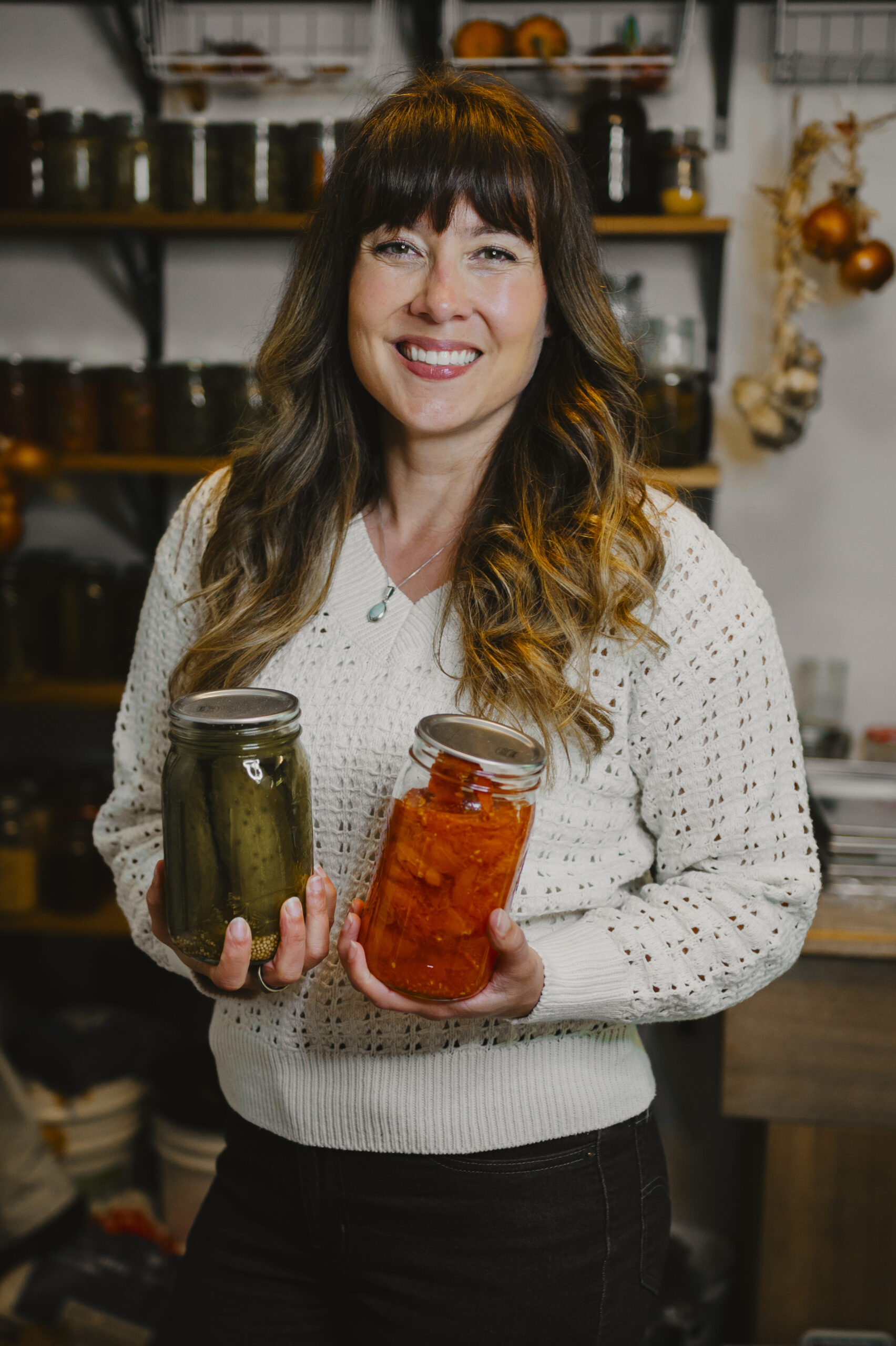
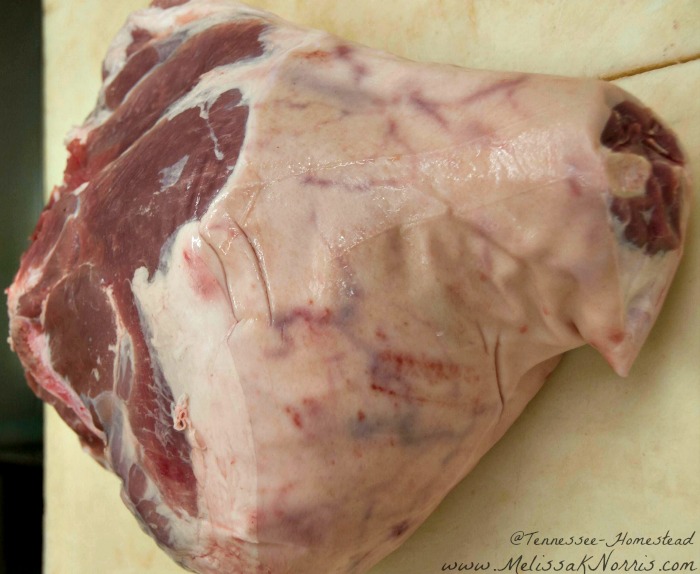
- Take a fresh ham with skin on, wash off in water and pat dry.
- Put a layer of curing mix on the tray to act as a bed for the ham. This bed of curing mix should be ¼” – ½” deep.
- Place the ham on top of the layer of mix.
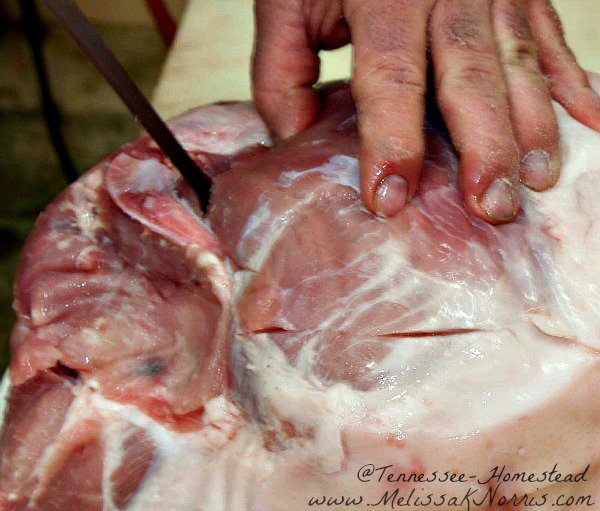
- At each joint, cut slits down to the bone. These slits are needed because you have to pack extra salt around the joint so the fluid will draw out. Otherwise, you could spoil the ham. There are two joints, the H-bone (hip) and the hock.
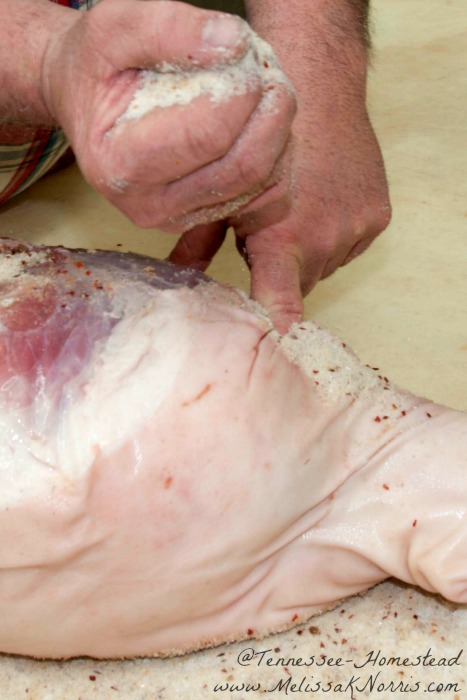
- Pack the slits you made at the joints with the curing mix.
- Rub and cover the rest of the ham with the curing mix.

- Leave the tray in a cool place (such as a refrigerator or a cooler packed with ice) for 18 days at 36-40 degrees. If using a cooler, be sure to check your ice daily and replenish it as needed.
- After 18 days check the ham.
- If you are going to put this ham in the smoker it has to be firm to the touch. If not firm to the touch it is not ready to come out of the curing mix. (If it is not firm it is because there is still too much fluid left in the ham.)
- If ham is ready to be smoked, thoroughly rinse off the salt and pat dry before smoking.
- If you are freezing then firmness does not matter. You can go on to the next step.
- If freezing, slice the ham and freeze or freeze whole.
- If ready to eat, you can bake the whole ham. Alternatively, you can slice the ham, soak the ham slices in cold water for up to an hour, then cook. Or, simmer the ham slice in a little water in the frying pan and then remove the water and continue cooking.
Related Articles You May Enjoy:
- How to Dry Cure Meat at Home
- How to Raise, Butcher & Cure Pigs for Best Flavor Without a Fridge
- Saving the American Guinea Hogs
- 12 Tips for Raising Pigs for Meat
- How to Cook Rabbit
- Cooking With Wild Game (So It Tastes Good!)
- 10 Ways to Preserve Food at Home
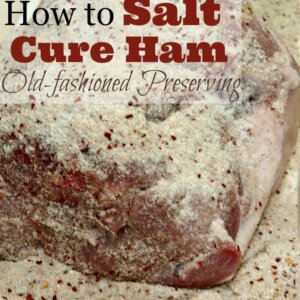
Salt Cured Ham: Old-Fashioned Preserving
Ingredients
- 6 cups Curing Salt
- 3 Tbs Red pepper
- 3 Tbs Black pepper
- 3 cup Brown sugar
- 1 Fresh Ham
Instructions
- Mix salt, red pepper, black pepper and brown sugar in a bowl and set aside, this is your curing mix.
- With a ham that’s between 36 and 40 degrees Fahrenheit, rinse in cold water and pat dry.
- Put a layer of curing mix ¼” – ½” deep on a tray to act as a bed for the ham.
- Place the ham on top of the layer of curing mix.
- At the H-bone (hip) and the hock joints, cut slits down to the bone then pack with as much of the salt mixture as possible.
- Rub and cover the rest of the ham with the curing mix.
- Leave the tray in a cool place (such as a refrigerator or a cooler packed with ice) for 18 days at 36-40 degrees.
- Cure for 18 days (or more – see recipe notes).
- Once the ham is cured, rinse well with cool water then smoke it, cook it or freeze it for later (see recipe notes for cooking tips).
Notes
- If using a cooler, be sure to check your ice daily and replenish it as needed.
- If you are going to smoke your ham, it has to be firm to the touch. If it’s not firm to the touch, continue curing and checking it daily.
- If ham is ready to be smoked, thoroughly rinse off the salt and pat dry before smoking.
- If you are freezing then firmness does not matter. Slice the ham and freeze or freeze whole.
- When ready to eat, you can bake the whole ham.
- If you’d like to serve the ham in slices, we recommend soaking the slices in cold water for an hour up to 12 hours in the refrigerator. Then cook up in a frying pan. (You can also simmer the ham slice in a little water in the frying pan, remove the water, then continue cooking.
Nutrition
Here on the homestead, cured hams are just one of the products we make from our own hogs. Other products include lard, bacon, ham, ham hocks, sausage and souse meat. If you are unable to raise your own hog many local custom slaughterhouses can help you find a producer you can purchase a hog from so you too can have your own fresh pork and enjoy the process of curing your own meat.
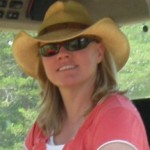
Lee is a writer/blogger who is also a self-reliance promoter. They call her chicken “Mama” at home where she considers herself an expert pitchfork operator. For more self-reliance and homesteading tips from Lee go to Tennessee-Homestead.com

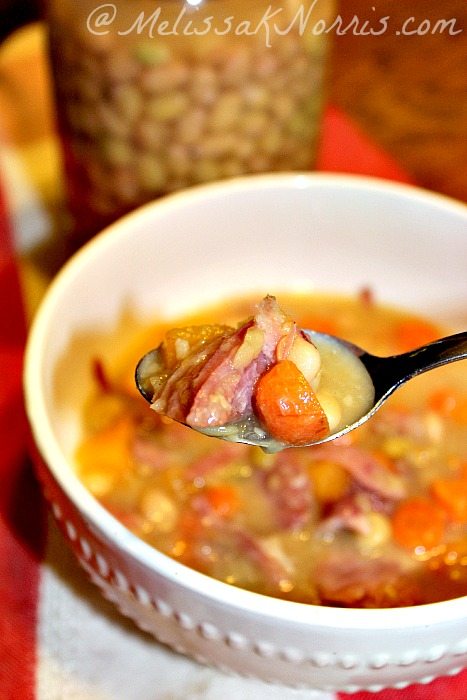


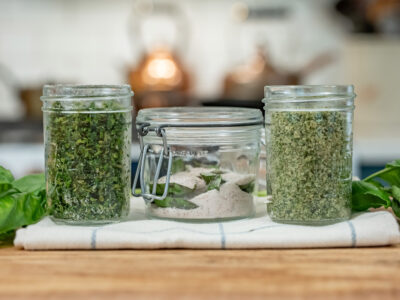






Hello!
The curing salt link is dead. I usually buy Anthony’s curing salt on amazon.com. He lists pink salt #1 (quick) and pink salt #2 (slow). Which one do I use in this recipe? Thanks!
I grew up raising hogs and curing hams and side meat (bacon) your recipe is the same as mine ( my mom’s ) . We used a real *built 1912) pine board smokehouse with built in wooden trays fior salting. Nowadays I have a canning/ food processing shed. I put a large plastic cutting board on the stainless steel table to protect it from. Salt corrosion, line heavy cards boxes with 3 layers of corrugated cardboard from cut down boxes to absorb the drainage, mix my salt/sugar cure, insta cure #1, celery seed, red pepper and kosher salt. Kill the hogs after Thanksgiving so the weather is reliably cool but not Sub freezing 24/7
Hi my name is james I like this cure ham recipe but I had to put it in large should I turn ham ? Could I put ham in pail with hock bone down when in fridge? Do I cold smoke for few hours then hot smoke ?
mill of tanning for leather
Yes, infatuation this condition Terrific article
i correspond with you
vendor of tanning extract
Up up up, tolerable
It’s exhausting to rephrase
vendor of nature extract
vendor of green plant
Yes, charge from this place good article
manufacturer of plant extract
vendor of plant extract
vendor of plant extract
Can this book be purchased in paper back book?
Hi! When you use the cure, are you worried about the nitrates and nitrites? As an organic homesteader myself I stay away from it. But I would love to hear your thoughts.
I cured a ham in my refrigerator, I had family. Issues and forgot it in the back of my fridge for 4 months!!! Is it ruined?! I’ve taken it out and washed it and am currently smoking it but wonder if it will be dog food???
after you dry cure and smoked the ham can you leave ham at room temperature are does it need to be refrigerated
Yes it does
Just exactly what is your curing salt.Is that salt with Cure mixed with it or is it pre mixed stuff like Morton’s tender quick/Known as curing salt
Pretty sure OG homesteaders didn’t have a spare refrigerator to “sacrifice” every time they wanted to cure ham….
Thank you for recipe!! I am from Ms, North since ’86. Not going back, (4 seasons not 2). I never had the chance to learn from Mama or Aunt Edna. Uncured hams are very hard to get up here in Me. All I could find is a whole(preferred, do not like half…) shoulder butt as they call it. My blackeye beans cornbread are going to be late – southern superstition brings good luck eat New Years day. I want to bake it to help heat kitchen in 167 year old 2 story house. I have backing time per pound. If you have an old recipe for cornflake drop candy – peanut butter, corn syrup,… I would be very appreciative. Again thank you. Happy New Year.
For How long should the ham be smoked if we chose to smoke it.
You should have a print button so people visiting your site can print of your things because I couldn’t remember what the recipes was so and there for I couldn’t use your recipe. Do you have a recipe on how to smoke cure a ham.
Please tell us what kind of red pepper?
Thank you
A old country boy from kentucky, me, says y’all make to much out of this.
October when weather starts cooling off, git your ham, a big bag of curing salt, an old feed sack or burlap bag that a little air can circulate in. Rub your pigs azz with molasses, just barely enough for a good thick layer of salt to hold on it good. Put it in the bag and throw in more salt. Hang it till January outside in the barn, dry.
When ya cut it, it will be different colors and stank. That means ya did it right. Slice some off. Repack with salt on the new cuts, lett her hang.
Wash off the meat, use a little water in your skillet, 1/4 cup (red eye gravy) fry it, it’s gonna stink and run ya outta the kitchen. Good, ya did it right.
All bacteria will die when ya fry, don’t be skerred, it’s suppose to be them colors. Now that’s some stinky old salty ham.
Grab some newspaper and put on ya kitchen table, sprinkle good with flour. Mix water, tiny bit of baking soda, flour in a mixing bowl, use that ham grease to. Roll out some biscuit dough, use a big mouth jar and make your biscuits (catheads). Grease your pan heavy with lard.
Lord, a few fried eggs and you got a whale of a breakfast.
Hi there
I’ve just cut into a ham I’ve cured for around 18 months, and it looks and smells great. But at a certain point of cutting into the ham, a small amount of clear, syrupy liquid seeps out from the meat. Any idea what this could be?
My name is Kent , hello. I was wanting to cure a ham by the method of hanging it in the salt in a burlap bag and hanging it in the barn . Do I cure it in the fridge for the 18 days and then hang it up in the barn???
Your recipi doesn’t say if this now cured ham is ok to be kept hanging somewhere or if it must be frozen… I’m looking for a recipie where I can keep it hung…
Can you please give me directions for salt/sugar curing then hanging hams to age. I grew up with a Dad who did this every October with his buddies and we had “aged” country ham all the time. Now I can’t find the protocol.
[…] a year and rendered that down into lard(How to Render Lard). We used Mortin salt and salt-cured (How to Salt Cure Your Own Meat) a lot of it, I think, was the name of it, and you rub that salt into the meat and it cured it. […]
Where can I buy salt cure ham old fashion preservation?
Where can I buy the book “how to cure ham old fashion preservation”. I real would like to read it.
Ira
Thank you so much for your post. I have a question,
How long do you smoke it if you have acces to a traditional Smoke house and can you store it in room temperature after it is smoke with your method?
Will Kosher salt work just as well as Curing salt? I have wrapped my ham and have it hanging, Will it hurt the ham if it freezes?
Do you also know that meats that say “uncured” on the package are actually cured in celery juice, which is a natural source of nitrates? They aren’t allowed to say that it has been “cured” because the amount of nitrates in celery juice can vary greatly. In order to have the word “cured” on the label, there is some set minimum of nitrates that the government says the meat must be cured with, which cannot be guaranteed with celery juice “curing”. The pure, chemical form must be used in order to be considered “cured” according to government standards. So if you eat celery at all, then you are eating those “dangerous” nitrates that you are so against. Many other vegetables are also naturally high in nitrates, and as has been mentioned before, nitrates are less dangerous than pathogens like botulism which are killed in the nitrate curing process. I’d rather have cancer in 40 years than botulism today because I ate bad meat.
How long to smoke the ham and at what temp?
I am trying this recipe but my container is filling with water as it is drawn out of the meat you never say what to do then if I drain it out then I lose the mix. Do I just keep adding mix?
Well although I am not so worried about having a small amount of nitrates occasionally as I do not seem to react to them the limited times I have them, some of the other ingredients are very concerning.
I need to find a true old fashioned recipe from an older type of book or homesteading website as the ingredients of the ‘curing mix’ type of salt with the ingredients of: salt, sugar, propylene glycol, sodium nitrate and sodium nitrite, a blend of natural spices and dextrose (corn sugar).
Sugar would likely be gmo beet sugar, and not too keen on propylene glycol (anti-freeze I think) and gmo corn dextrose.
Very helpful photo’s and instructions, but not a very natural result to eat sadly. 🙁
Does this only work for pork or can this process be used on venison etc…?
Good post on curing ham 🙂 I am going to be starting the cure for two prosciuttos soon 🙂
Be well :
Michael J. Read
How did they cure hams before refrigerators
I’m trying to cure two 45 lb hams. So far doing good.
They have lost at least a couple gallons of liquid.
It has a good pink inside so far.
They butchered in the fall when the cold was coming on.
I’m 85 years old and always remember seeing red pepper when Mom and crew was curing the hams of fresh meat. I always wondered if I was correct in my memory, now I know I was. Thank you for the information. R P E
Can a air dry ham be cured in a cloth ham bag? If yes, How long do I cure it in the bag?
Hi,
Once my ham has dried and ready for the smoker, how long do I smoke the ham for and at what temp? And, do I need to refrigerate the ham after it has smoked? I can vaguely remember Daddy storing our hams in the smoke house. At least, I think he did. Thanks for all your help. Shirley
Hello there, nice article. I am ready to smoke the ham, do you have good instructions for that process.
Hi Melissa !! I am a follower of JESUS as well. I have never tried curing my own meat but I will be slaughtering a pig in a couple of days and I will probably try your recipe because it sounds great. Question Do you have a recipe for bacon curing as well? Thanks and GOD Bless.
Alvin, I don’t here, but my friends over at Swiss Hills Ferment do, here’s the link https://www.swisshillsferments.com/makin-bacon/
I can remember my parents using cheese cloths to wrap the ham in to. What step is that? Was that to store the ham after perserved. I have fresh game in freezer. I am country girl want to serve some red eye ham and gravy.
Good Morning!
Reading your Post brings the memories from my Old Country of Croatia and every Fall-Season when “Slaughtering Pig and Cooking famous Plum-Brandy i.e.: “SHLIVOVITZ” was being cooked in “Steel”. Custom lasted 3-5 days. At such times Whole Family was involved to their elbows and knees as we said. Thank You for bringing those memories back.
Happy Holidays, i.e.: Happy Thanksgiving and Merry Christmas from my house to Yours!
Great article, it made think of my grandfather who died in the 80s. He lived in the Ozarks and cured and smoked hams his entire life. He would do several legs at a time in an old bath tub outside. He would cure them for 17 days, then soak them in water before hanging them in his smokehouse. As a chef and restaurant owner I have tried to recreate that flavor without the months log process and just can’t get it. I have done them grandpa’s way in the past for friends and family. Once you have had a ham cured and smoked to perfection, you will never buy a store bought again.
Amen!
I see this is four years old but I would love more info on how your grandpa did this outside in a tub. Did he do it in the winter? Just wondering if it has to be refrigerated.
My question is, how can you cure meats without using sodium nitrate or pink salt, because my wife can’t have it, Help please
The nitrites protect against botulism, which is a risk in an anaerobic environment. Kind of necessary when curing a ham safely.
This is the best website I have found for curing ham. I would like to smoke the ham after curing. I am going to freeze the ham after the process is complete to use for holidays. How long do you smoke the ham and at what temp? What should the internal temperature be when I am finished?
I found good information at http://nchfp.uga.edu/publications/nchfp/lit_rev/cure_smoke_cure.html.
Hi, I started wuring a 2 kg piece of chump joint ham. USing total submersion method. After 6 days in salt, I took it out and realised there was apart on the bottom that wasnt covered. There was a flap of meat and I didnt get alt on the inside. The meat here smelled a bit off after I washed the pork. Can I save this meat? Any advice? I put salt into this part and put it in the fridge last night. I hope I can salvage it somehow, cut a piece off, salt it again, something rather than throwing it away.
Yours Brian
I think you are talking about curing salt that has the pink salt already added when you say use two cups. I have my pink salt separate. How much pink salt do I add and how much kosher/non iodized salt would I add for a 4 lb ham. (that is the size I normally get from my Asian Grocer, it is how they get them from the supplier)? Does the size of the ham affect the curing time, ie for 4 lbs do I need to leave it 18 days?
We skin our wild hogs. I assume its ok to cure a ham that has had the skim
n removed ?
I think so Mike, our ham doesn’t have the skin either.
Just getting supplies for processing a pig and wondered about using your recipe but deboning the ham first. Other than reducing the cure time, would this work. I plan on storing it in the freezer until prepared. Is the nitrate necessary? I will use it if I have to, but if it is mainly to preserve color then I am not. Thanks.
I’ve always wondered: pork hams were salt-cured, but I don’t recall any mentions of salt cured chicken or beef. Was there a reason? I suppose chickens were butchered on demand, but beef?
My mom used to make dried cured beef and venison all the time. Think chipped beef.
This is the first year we have had hogs! And actually I have one ready to go to the slaughter house. They will do the cutting, but we are going to cure the bacon and the ham!! Wish us luck!!
Awesome, Lisa! Good luck and I’d love to hear how it turn out for you guys.
I cured a ham in my refrigerator, I had family. Issues and forgot it in the back of my fridge for 4 months!!! Is it ruined?! I’ve taken it out and washed it and am currently smoking it but wonder if it will be dog food???
Did you get a response? I had the same thing happen. It’s hanging in my barn.
Hi, awesome article! Just curious what kind of curing salt you recommend? I know there is pink curing salt but it seems to come in small packages… I am just unsure on this part. Please get back to me! Thanks!
Curing salt does come in small packages and not large amounts are recommended in your recipe it calls for quite a bit of curing salt is it a mixture of curing salt and salt let me know thanks
Morton curing salt, what you are talking about is no good.
[…] How To Salt Cure Ham Old-Fashioned Preserving – I don’t have a homestead, but this may be beneficial information to have on hand in the event that a need comes along to be able preserve your own meat. […]
When you slit at the joints are you slitting them from joint to joint or making 2 slits at each joint, thank you
Do you have a recipe/process to sugar cure a ham?
Nitrates and nitrites are NOT healthy ingredients! Using rock salt and saltpeter are better, healthwise, and there are recipes out there that use these ingredients rather than unsafe nitrates and nitrites.
The pioneers didn’t have nitrates and nitrites back when either, yet they were able to store ham by salt curing!
Thank you for your post.
But, did you know that saltpeter is potassium nitrate?
Thanks again.
Lee
you didn’t tell me how much the ham weighed for your recipe.
Questions
Whats the price please?
Saltpetre has long been banned from food production in most countries due to the health risk, sodium nitrite is a much safer alternative. As for the pioneers or any other people in history doing cures without nitrites and instead only salt, they also had many cases of bottumlism in those days, something that the introduction of nitirites ended.
Sodium nitrite is poisonous in too large of a dose plain old non iodized works great
Saltpeter technically is potassium nitrate (kno3)…
What you said Carol is part true. Saltpeter has nitrate in it. Nitrates are used to prevent bacteria from forming. They also add that ham flavor everyone knows of. True you do not need it on hams. Dried sausage pink salt #2 is definitely needed. Pink salt #1 is used on any meat that’s will be cooked. Like smoking for fresh bacon sausage and ham. Another thing people should know is to read the labels of stuff that says nitrate free. It’s is not nitrate free. It will say except for what naturally occurs and celery. Vegetable naturally have nitrate in them. Not all but some do. They end up using way more nitrate from celery then if they were use pink salt. Bottom line is nitrate is nitrate from a vegetable or not. It’s the same chemical make up. Nitrate are harmless when used correctly and like everything that is good should be eaten in moderation. There is no science backing up that nitrates are bad. This is my profession and I use nitrates whenever it’s needed. It’s for food safety. Country hams prosciutto spalla lardo and Lonza I do not use them. So please do not be scared of nitrate. It’s your friend for success in curing meats and adds a nice flavor.